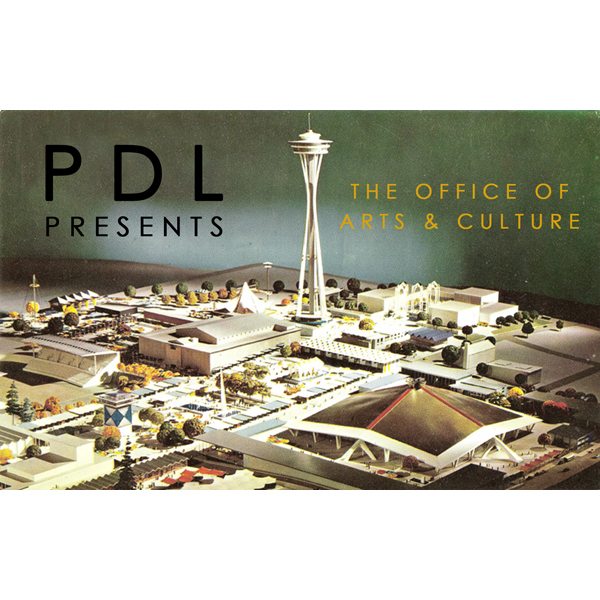
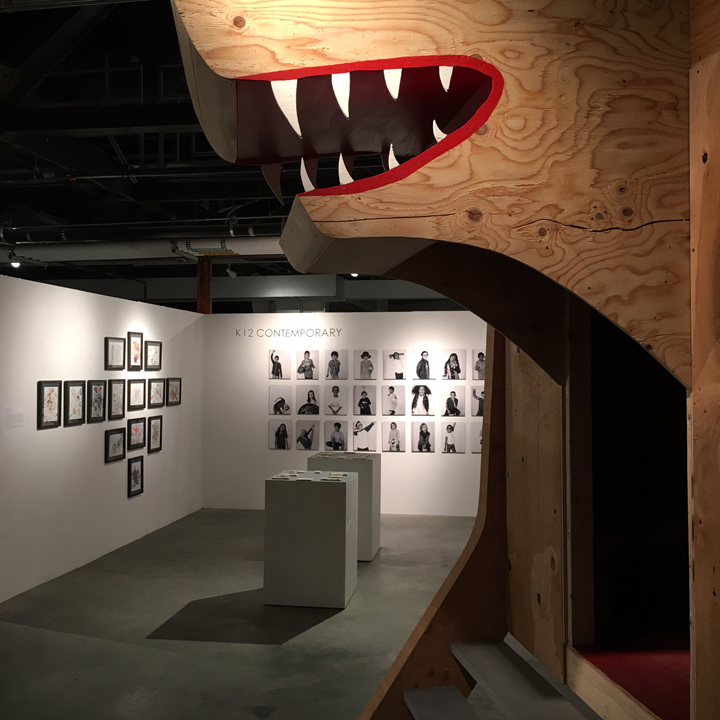
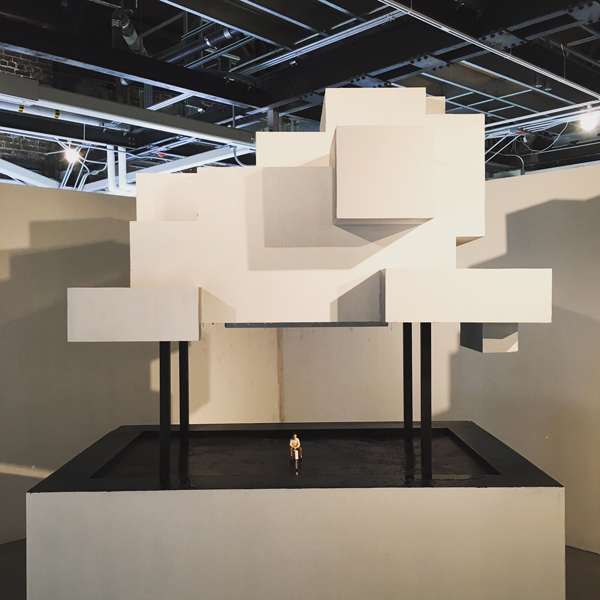
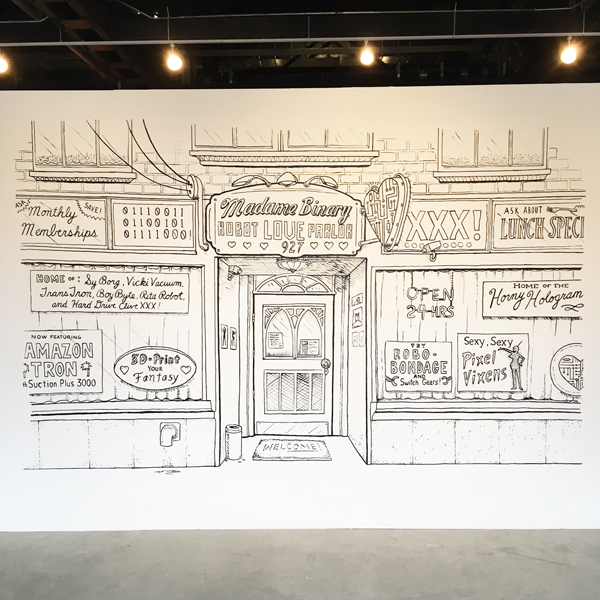
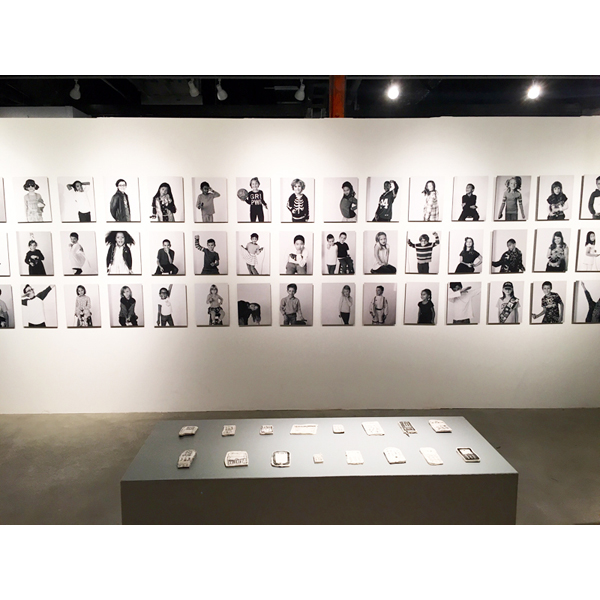
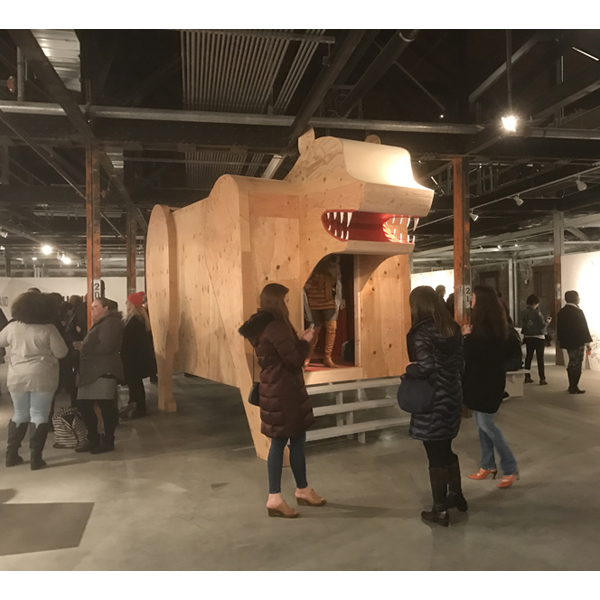

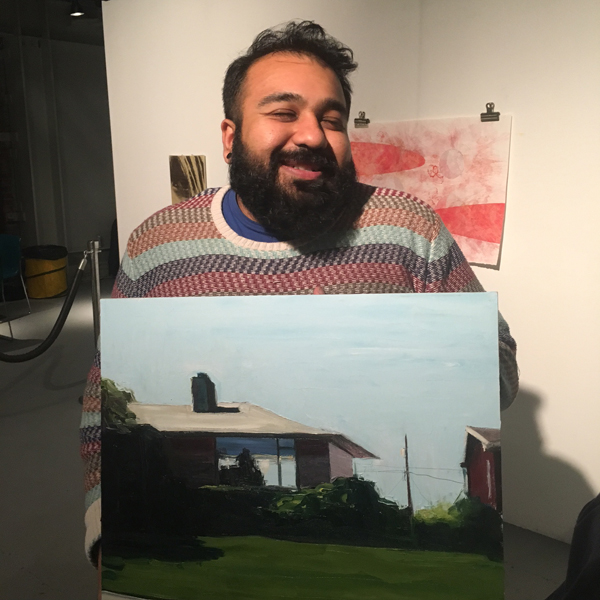
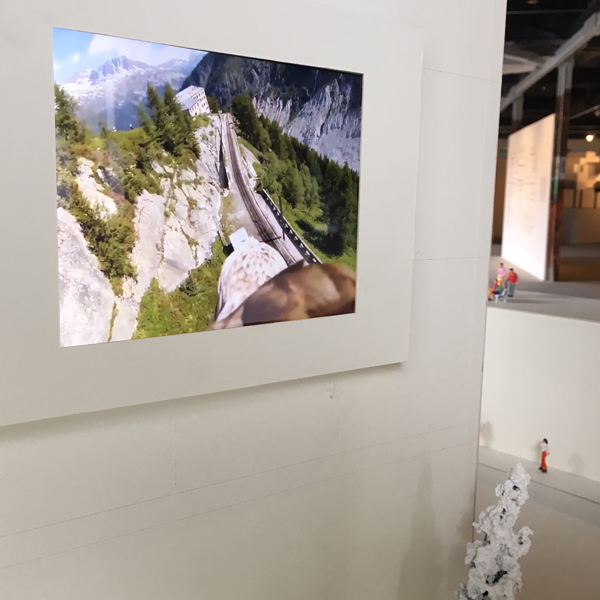

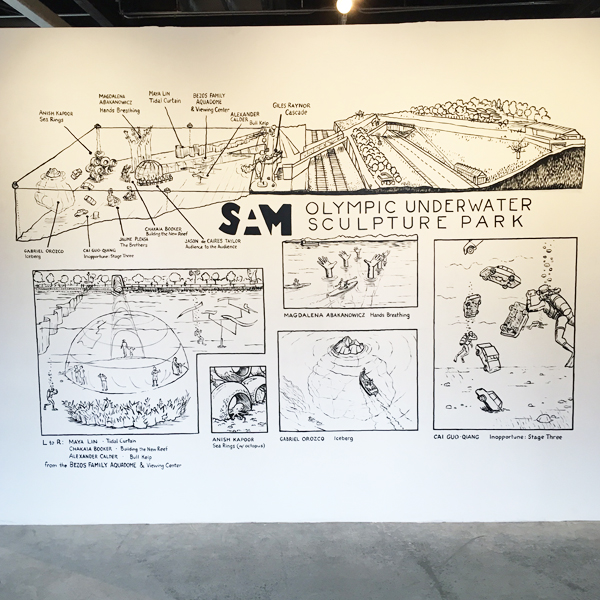
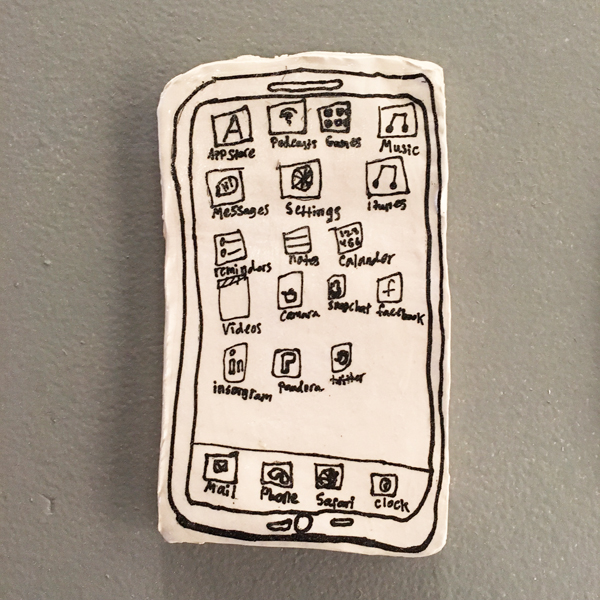
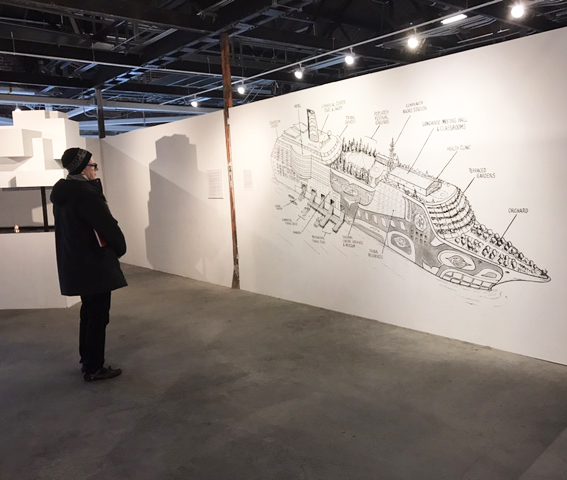
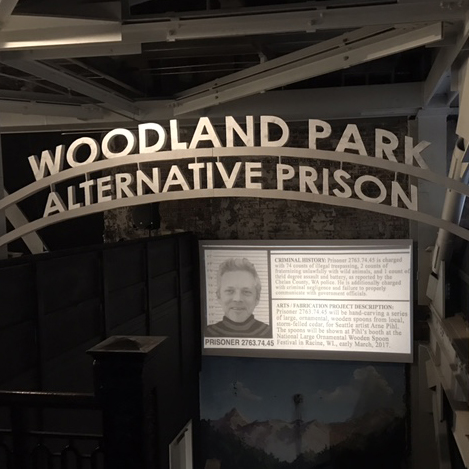
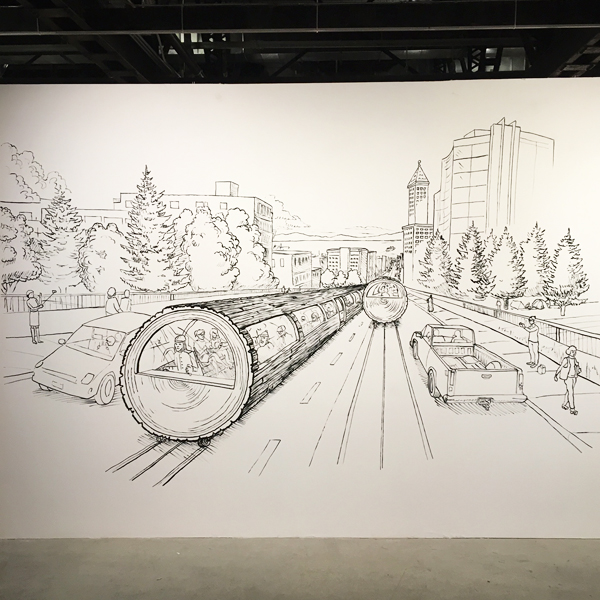
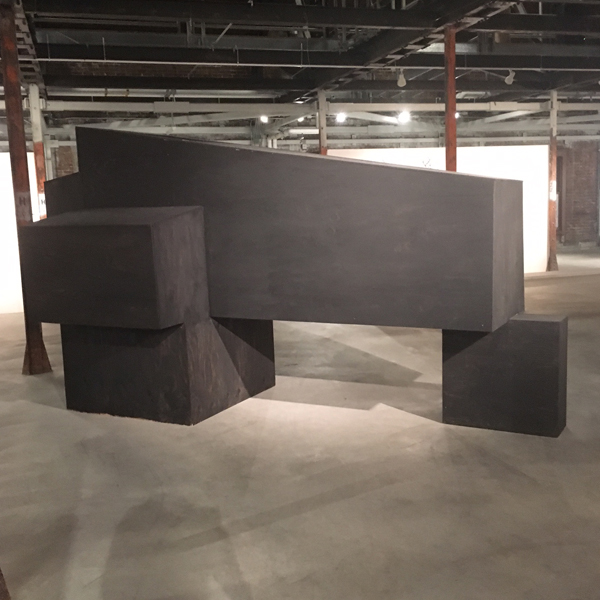

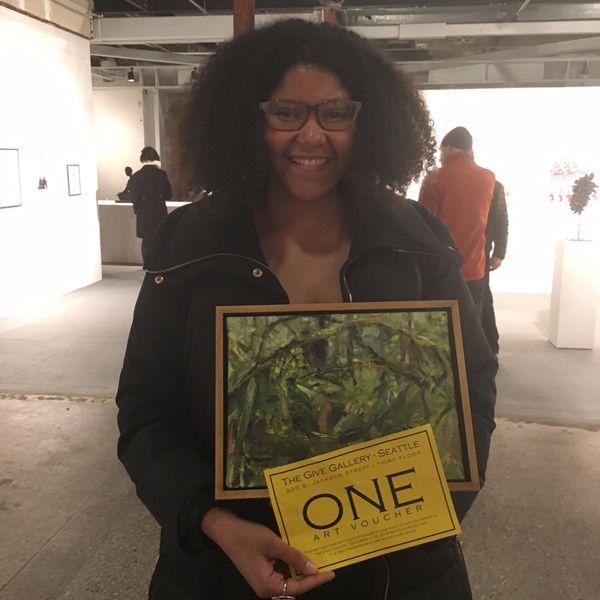

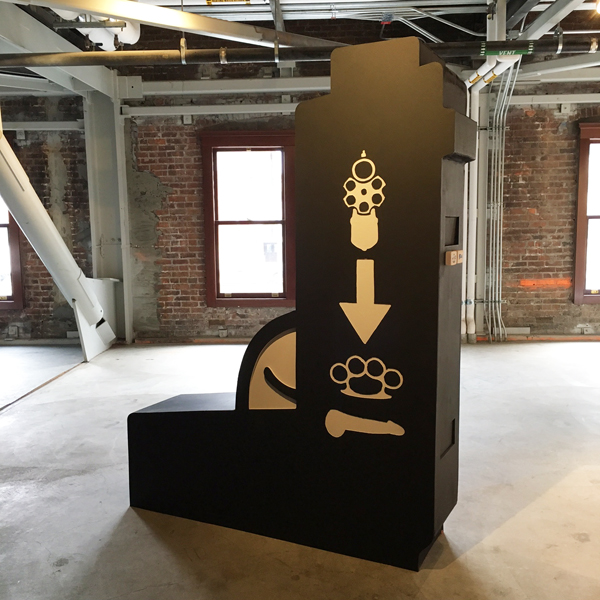
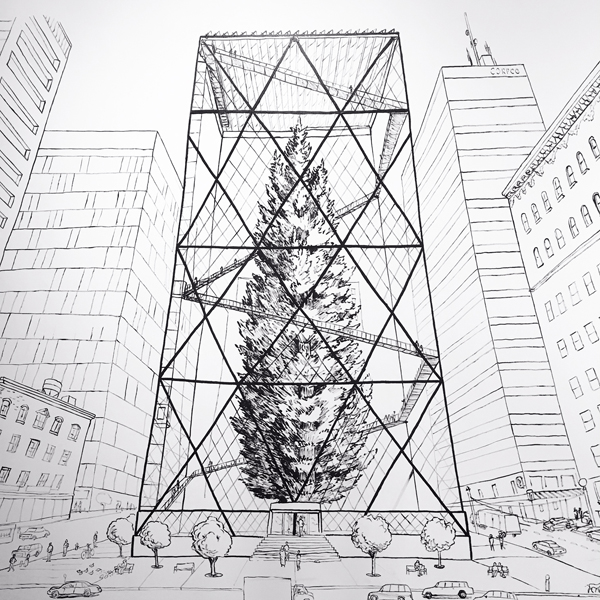
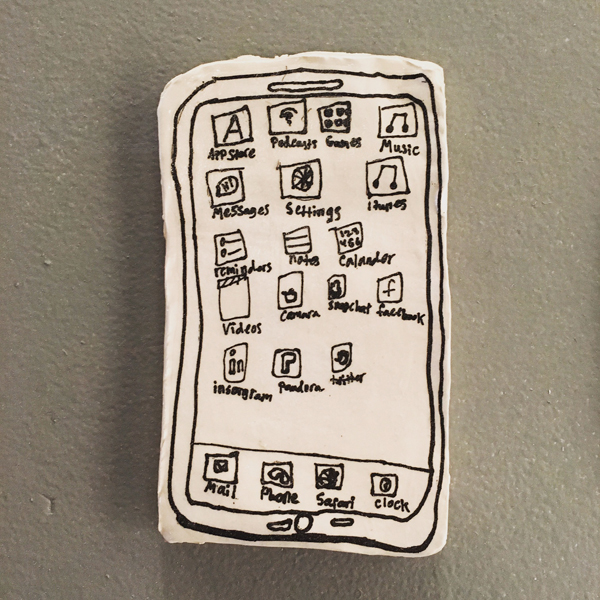
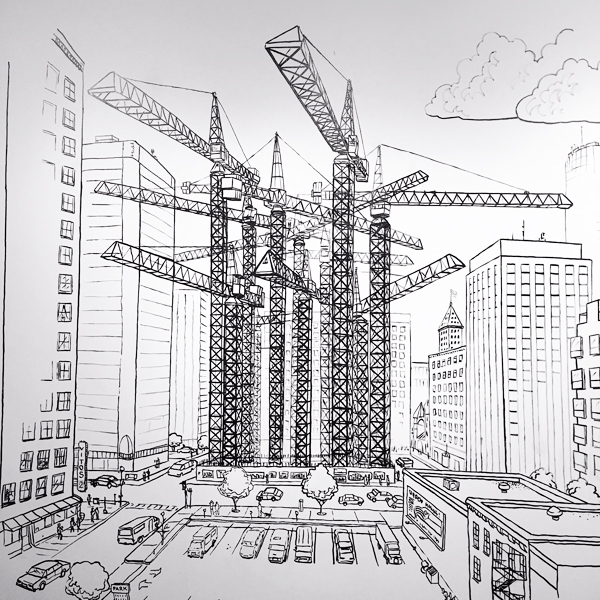
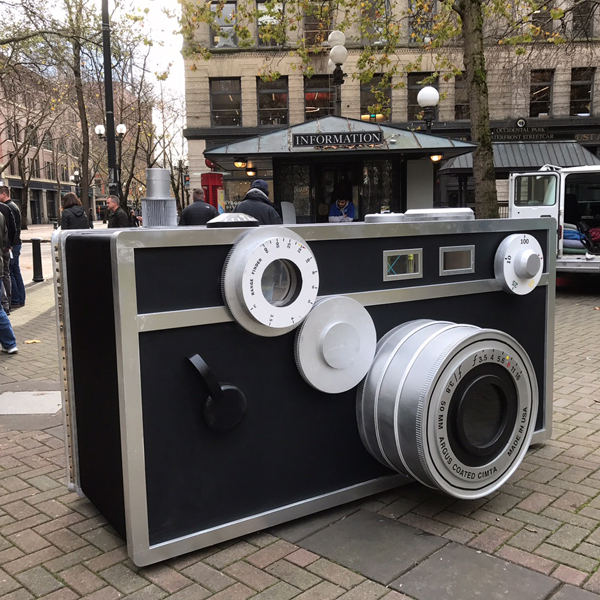
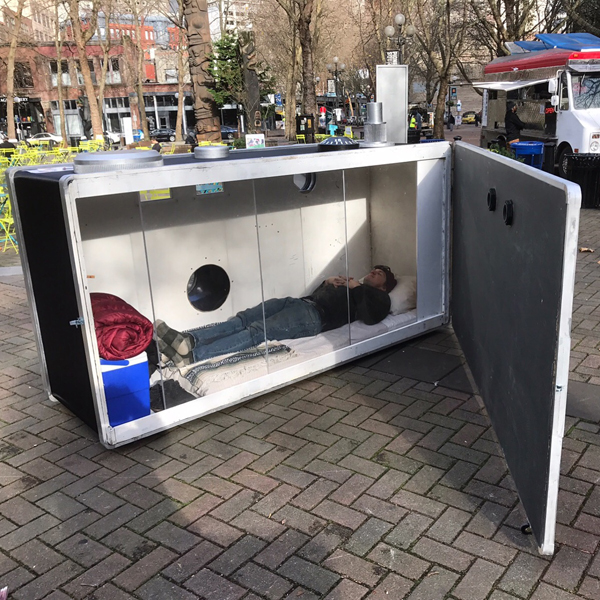
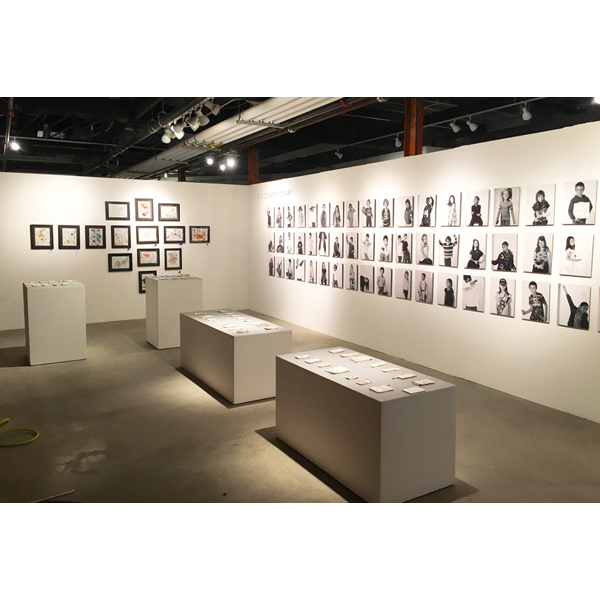
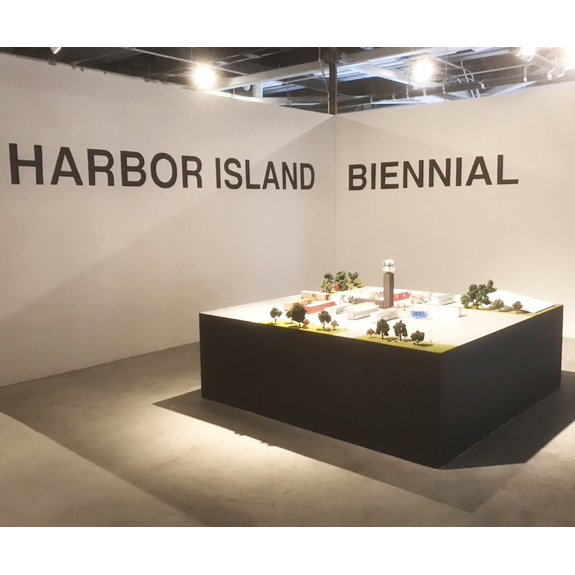


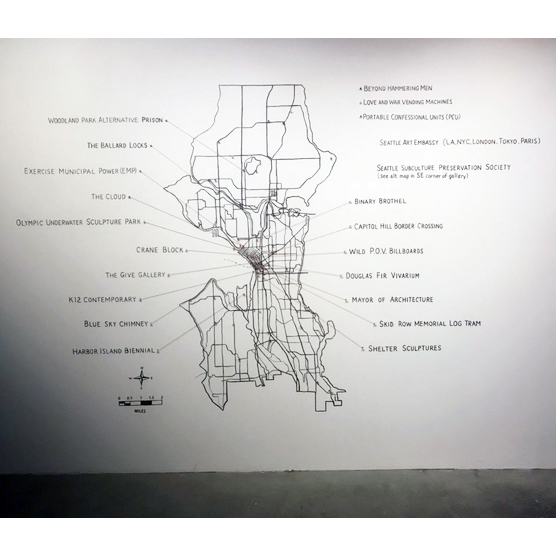

The Seattle World’s Fair in 1962 was a time of great optimism and excitement. It represented what Seattle could become and, by many accounts, was called ‘City of the Future’. Artists, designers, and big thinkers all imagined a future that captivated the region’s, and world’s, attention.
That was a long time ago.
For many of us, that early enthusiasm has been replaced with frustration and negativity. Optimism has derailed in the name of economic growth. Our faith in a better city, a better Seattle, has eroded as gentrification and politics have failed to usher in an equitable and progressive platform for diversity, innovation, and sustainability. Our 1962 enthusiasm has become tarnished and faded. Our dreams have been scaled back from ‘City of the Future’ to ‘City Just Trying to Keep its Shit Together.’
On December 1st, PDL presented The Bureau of Arts & Culture – a new exhibition outlining 21 creative proposals designed to return the city to a place of optimism and excitement. PDL reimagines Seattle through various private- and city-sponsored projects, which, among other things, artfully tackle homelessness, income inequality, cultural tourism, the re-imagining of public space, and the future use of King Street Station, EMP, Harbor Island, Woodland Park Zoo, the Olympic Sculpture Park, and our downtown core.
1 - K12 Contemporary
Artists are not defined by their ability to paint, or sculpt or play a guitar so much as they are by their ability and confidence in communicating their ideas, standing up for what they believe in, and dreaming big dreams. They are the seeds that re-imagine our cities, our businesses and the cultural network that drives our identity and path forward.
In the global economy that welive in, there is a quiet but aggressive campaign to seduce and import creative talent from around the world - understanding that a healthy population of artists are good through all aspects of city life. New York City was a champion of this technique - ‘brain-draining’ smaller towns around the United States and sending out a siren song to ambitious, creative youth that the Big Apple was indeed the place to be if you wanted your voice to be heard as an artist. It was an incredibly successful campaign as thousands of young artists fled to New York to pursue their dreams.
Seattle needs to actively message this same ideology - that we are the place to be heard and seen, that we have a culture that fosters expression across disciplines and contains the infrastructure and consumer base to nsupport creative expression.
Importing artists is good business but it is an incomplete campaign if it fails to recognizeand foster the talents of the thousands of students already living within our region. As a city, we need to provide better arts education and give exposure and inspiration to the children and young adults currently in our city. In short, we need to go beyond drawing class and pottery - we need to impress upon our youth that art is much more than an advocation - that it is a highly valuable and essential skill in creating a healthy21st century America.
The Bureau of Arts & Culture recommends that the third floor of KIng Street Station be named K12 Contemporary and serve as a for-profit gallery dedicated to the exhibition of budding elementary, middle and high school students. A K12C apointed curator will work in tandem with our public schools system to develop, program and exhibit student art with profits quartered between the artist, the school, the district and K12C.
This proof of concept display exhibits student work from Montlake Elementary and Franklin High School, and all works are for sale. Proceeds will be divided as per our proposed model and your purchases directly inspire our city’s young artists and help underline that art is not just a hobby but an essential part of our culture and economic drivers.
2 - Shelter Sculpture
Seattle has a housing crisis on all fronts. It is expensive to buy a home, expensive to rent a home and our homeless population has reached critical levels. In a city as wealthy as Seattle, one would expect better social services to keep people warm and dry, but it remains a problem without a solution.
We are also a city with a large population of artists, designers and architects that care deeply about our city and the housing problems that surround us. We harbor a deeply invested community of creative thinkers and builders who want to give back, if given the opportunity.
The Shelter Sculpture Program recognizes the need for public art and the need for publically funded housing, and proposes to work with our creative community to address both issues with one program.
Highway underpasses, vacant lots and downtown courtyards all present themselves as viable, usable space to introduce sculpture with two purposes – to increase the visual landscape of our urban core, and to provide shelter for those in need.
The Shelter Sculpture program would commission public sculptures from our existing 1% for the arts city fund, as well as from regional artists, architects, contractors and designers who see the opportunity as a creative challenge and civic duty.
Until a more comprehensive solution to end homelessness in Seattle presents itself, we need to be creative, innovative and ask more from our city commissioned public art. We believe that it can be bold, dramatic and aesthetically interesting AND provide shelter for those in need.
The Bureau of Arts & Culture recommends that the city define locations condusive to Shelter Sculptures - particularily the area refered to as “The Jungle” in addition to other underpasses, open spaces and city parks, and incentivize artists, designers and architects to participate. They further petition that all future public sculptures be designed with the duel purposes of serving aesthetic as well as functional housing for the displaced members of our city.
3 - Social Services Gallery
Seattle harbors thousands of visual artists. And these thousands of artists are often prolific, generative makers, yielding thousands of art works each year. It is an arsenal of work that would fill an airplane hanger if gathered and stored. Some of it sells and a lot of it sits in studios, storage units and stacks. It has value, potential energy, but often the unsold works greatly outweigh those that sold.
The Social Services Gallery serves as a depot for these unsold works. It is a curated collection founded upon regional donation by artist and collector alike (who also often have works that they would be happy to see put back into circulation), with a storefront showroom exhibiting and dispersing this trove of art to the citizens of Seattle. What makes it truly unique is that no money exchanges hands in the Social Services Gallery. If a visitor wishes to acquire a work exhibited in the gallery, it can only be claimed with an Art Voucher.
Blood banks have Art Vouchers. Soup Kitchens have Art Vouchers. Neighborhood patrols have Art Vouchers. And if you would like one, then you give blood, or volunteer or serve the community in one of the many understaffed programs around the city. Volunteering for just 4 hours grants you an Art Voucher. And one Art Voucher is redeemable for anything on exhibit in the Social Services Gallery.
For this ‘proof of concept’ we have partnered with Bloodworks NW. If you donate blood in our mobile blood draw station at King Street Station, or at a Bloodworks NW center December 1 – 18, you will receive an Art Voucher. And that can be traded for any of the 300+ works on display.
The Bureau of Arts & Culturerecommends that the city partner with regional social services and incentivize citizen participation through use of Art Vouchers. A city run gallery will solicit and exhibit artist donated works in a rotating display, redistributing artwork to participating collectors.
4 - Harbor Island Biennial
Seattle is a port city, with international maritime traffic importing and exporting goods from around the world. Harbor Island is the center of this commerce, loading and unloading ocean cargo containers on a daily basis. While we might be known for our tech industry, for coffee or airplanes or rock and rock, Seattle is the third largest port on the west coast and with that title comes great opportunity to host an art biennial.
The message is simple: Any country from across the globe is invited to participate. All they have to do is transform or populate a 40’ ocean cargo container and have it shipped to Seattle. When their container arrives in the port of Seattle, it will be staged on Harbor Island along side other participating nations, and opened up for public exhibition.
The first year may see 20 containers. The second year may see 50. But with the cost to participate being so low, and the infrastructure to receive and display already in place, it is a compelling, inclusive and unique way for countries around the globe to participate in a growing and rich international exhibition.
Countries can decide if the cargo container will be painted or modified, if it will serve as a small gallery or as a sculptural object, if the contents are designed to spill out into the 8’ x 40’ real estate that each country would be given. It challenges how space is used and how each country approaches the constraints of shipping.
The Bureauof Arts and Culture recommends a month long festival with cultural partners (many of whom live in the pacific northwest but have cultural ties to the participating country) augmenting the biennial with music, dance, performance and food.
Hosting the Harbor Island Biennial can leverage our shipping infrastructure to host a growing and diverse portrait of international arts and culture in a way that drives tourism, connects far away communities and brings the world to our doorstep.
5 - Seattle Art Embassy
Cultural tourism is a multi-million dollar industry in Seattle. We have world-class art, music and theater. Our underground culture is vibrant and our institutions are vast and diverse. But how do we message this vibrancy to the world? And how do we continue to sustain and grow this cultural wealth to both retain our current creative community and encourage others to move here?
The Seattle Art Embassy is a brick and mortar storefront located in major international centers (New York, Tokyo, London) that’s mission is two fold – to exhibit and inform residents and tourists in other parts of the world about the constant wealth of programming, arts and culture happening in our city, and to offer support and guidance to Seattle residentsand artists looking for culture and opportunities in the host city.
The Seattle Art Embassy would mount visual art exhibitions from PNW artists, showcase literature, films and albums, and inform daily the hundreds of arts events happening in Seattle that day, week and month. It would host lectures and readings, films and pop-ups, presenting the city as a dense, active and cultural engine. It is a tourist agency for the city, a art dealer for the city, and a friend to visiting Seattle artists.
The quality of urban life and economic health of a regional economy is directly related to the amount of artists, thinkers, dreamers and makers that inhabit it. For decades, New York City was the destination for artists and dreamers – if you wanted to make it, you moved to New York. If you were looking for excitement, you moved to New York. And the results of this cultural campaign were staggering.
Seattle needs an Arts Embassy program to constantly remind and aggressively persuade artists and dreamers from around the world to come to Seattle. It needs to inspire collectors to buy Seattle art, for tourists to visit our regional culture centers, and build upon the foundations we currently have. We need to be aggressive in the ways we market our city and we need to be aggressive in providing opportunity to the rare, brilliant voices that call Seattle home.
6 - Love and War Vending Machine (Gun Depository)
We have a real problem with guns. And the bulk of that problem is we just have way too many of them. We can look towards the Supreme Court to fix this problem, we can look towards a hundred politicians and new social service programs, but at some point we just have to act and implement systems that immediately, and successfully change the volume of guns in our community.
If a large part of the problem is the quantity of guns in our community, than a large part of the solution isreducing that volume. Gun Depository’s are not a new idea, largely because there is little motivation (beyond public good) to participate in them. What we need is a better incentive to get rid of a gun. Maybe we can even make it interesting.
The Gun Depository are steel sculptures the size of a vending machine, that are placed in strategic locations within the urban core. They have a gun slot, much like that on a postal box, that receives the unwanted gun, and a receiving bay that delivers what this unwanted gun is transformed into.
There are two buttons on the Gun Depository – Love and War. Press ‘Love’ and your weapon is melted down and cast into the shape of a dildo. Press ‘War’ and your weapon is melted down and cast into the shape of a pair of brass knuckles. It is your decision what that gun transforms into. And it all happens within this steel sculpture, changing guns into scuptures while you wait.
The Bureau of Arts & Culture recommends that 10 Love and War Gun Dispensories be built and installed on the streets of Seattle. We don’t think these vending machine will erase all gun related crimes in our city, but we do think they could save a few
innocent people from gun violence. And a vending machine that can do that is a vending machine our city should invest in.
7 - Binary Brothels
Seattle hosts one of the largest populations of illegal sex workers in the nation. It is a problem we rarely talk about and one that our city does little to curb. Granted, prostitution is one of the oldest professions in the world, but in an era of so much human trafficking, drug use and lack of opportunity, it has created a dangerous environment for women around the world. It is not a problem we can ignore or assume as an engrained part of our culture.
At the turn of the century, Seattle’s timber and fishing industries brought thousands of single young men into the region. And prostitution flourished. And with the boom of Amazon, Microsoft and other technology companies, this surge of single men also helps foster human trafficking and illegal sex workers in our region. This time though, there is an opportunity to harness our technology community for the solution.
Binary Brothels are recreational sex clubs that employ virtual, digital and robotic sex workers to provide safe, legal company to those willing to pay for sexual encounters. They are open 24 hours a day, encouraging people to direct their sexual energies into outlets that curb sexual abuse, violence and disease found in illegal human to human contact.
Whether you chose to spend an hour with Boy Byte or Vicki Vacuum, or make sweet love on a space ship in a distant galaxy, Binary Brothels provide a humane and imaginative way to channel sexual energies that historically compromise the lives and health of women around the world.
The Buereau of Arts & Culture recommend private sector development of Binary Brothels in Bellevue, Redmond, South Lake Union and the SODO district. These privately run enterprises would offer digital and robotic services to a diverse audience, augment cultural tourism and stand as an alternative to our current, and troubled relationship with illegal and undocumented sex workers.
8 - The Cloud
There is a reason why Seattle is brimming with creativity and high-tech brainpower. It isn’t our fashion sensibility or fondness for coffee. The secret to our success is the same defining characteristic that has kept foreigners at bay for decades – our rain.
Our arts and culture, business innovation and progressive politics all feed from the same cloudy skies. Our rain defines the way we think and the work we create, and it is time to take civic pride in it and recognize it as our greatest natural, and creative resource.
The Cloud is a large-scale kinetic sculpture, 150 - feet long and floating 20 feet above the ground. While our climate is definitely changing, rain falls from The Cloud 24 hours a day, 7 days week. Designed for Seattle’s urban core, it insures visitors a constant downpour, even on our clearest days, so that everyone may think, contemplate and find inspiration. It is an interactive experience and photo opportunity that tourists and locals alike will embrace as part of the essential Seattle experience. For the more timid visitor, artist designed umbrellas will shield them from the downpour.
Not only is Seattle defined by our grey skies, it is also one of the world’s leaders in cloud-based storage technology - that often misunderstood and mysterious digital space that stores your music, photos and documents. If you’ve ever wondered where all that information is stored - this is it (the red blinking light on the left hand side of the Cloud sculpture helping to underline this association).
Visitors and Seattle residents will be able to upload creative content and ‘brainstorms’ to the Cloud through a unique URL interface. The Cloud can post questions or creative challenges for visitors to respond to, harnessing and aggregating our collective creativity, to dream and contemplate our future. From politics to environmental issues, technology to social issues, the Cloud will ask questions and harvest answers from it’s rain-soaked visitors.
The Bureau of Arts & Culture recommends the construction of The Cloud to be located on the campus of the Seattle Center.
9 - Crane Block
The first two decades of the 21st century will be remembered as unparalleled times of growth in Seattle. This boom can almost be directly measured by the amount of construction cranes scattered across our landscape. At times there are over 60 cranes entending up into our city skyline, marking the new arrival of office buildings, sky scrappers and apartment buildings. In some cases, they represent the graves of lost architecture, in others, the birth of a new Seattle. What this new Seattle will look like remains unclear, what is not subject to speculation is the rapid growth and change that is happening before our eyes.
The Crane Block is a public sculpture cast of bronze and occupying one city block. It is a towering, densely crowded maze of construction cranes - packed so tightly that none could possibly ever do its proper job. It is both an homage to our construction era and a claiming of urban space otherwise earmarked for another building.
There will be a time when construction slows down and we can properly assess the impact of this quantum growth. Crane Block conveys the near absurdity of our urban growth and our inabilty to calculate its impact.
10 - Mayor of Architecture
Seattle is a rapidly changing city. Old buildings are being torn down and new ones are erected with lightening speed pace, often at the expense of the neighborhood and visual landscape that makes Seattle so desirable. Not all growth is good growth, and not all new buildings are complimenting our urban experience.
The Mayor of Architecture is an elected position designed to steward in and oversee this growth with an emphasis on innovative design, neighborhood improvement, cultural stewardship and long-term sustainability. The Mayor of Architecture defends the cultural assets of the city, directs responsible growth that stands the test of time. They are the gatekeeper - the final word on what gets built, what gets torn down and what is going to improve out urban landscape in long-term, progressive ways. This mayoral position is restricted to commercial buildings and residential developments over 4 units in scale.
The city of Seattle recognizes that a new building may last, and affect our collective landscape for over a century. We need a city-held, elected position to insure that the choices we are making, and the buildings we are replacing are to the advantage of the city and its residents. Issues of affordable housing, environmental sustainability, and neighborhood impact are also factors of approval beyond the craftsmanship and aesthetic of a structure.
This geographical territory is defined as north of the west Seattle bridge, south of the ships canal, east of Elliot Bay, west of 23rd Street.
The Bureau of Arts & Culture recommends that a new elected position be created under the banner of the Mayor of Achitecture, voted in by residents of King County to help address these growing concerns over the future landscape, use and sustainability of new developments in our downtown core.
11 - Blue Sky Chimney
As much as the grey skies of Seattle are a hallmark of our region, there is a hunger and psychological need for sunshine and blue skies. And instead of boarding a plane in search of sunshine, the Blue Sky Chimney presents the opportunity for year round local access to this much needed natural resource.
What exactly is the Blue Sky Chimney? It is a 500 foot diameter, 2,500 foot tall, clear polycarbonate cyninder that reaches about the cloud line, allowing visitors refuge from the overcast and drizzle that covers our city, on average, over 200 days a year.
The proposed site for the Blue Sky Chimney is the north end of Alki Beach - already our little slice of California. Providing year round sunshine gives the people of Seattle and tourists alike, the opportunity and access to that rare treat of warmth and blue skies.
The Bureau of Arts & Culture recommends that a sculture-as-park be built.
12 - Go-Pro Animal Billboards
The future of city living is stressful enough. With congested traffic, high rents, demanding jobs and threats of earthquakes, volcanic erruptions and global warming mount, we need civic engagement that reminds people why they live in the pacific norhtwest and the great natural beauty that surrounds us.
Currently, the advertising community is designed to sell us things. It is a mirage of products we don’t need and services we could often do without. The Bureau of Arts & Culture recommends opening up a dialog with local businesses to change the way in which we employ our city billboards - using these large canvases as opportunities to remind people of the rugged natural landscape just outside our door, and to calm, inspire and reduce the stresses of our citizens.
Working with the department of Fish and Wildlife, micro- video cameras would be mounted to eagles, salmon, orca whales and beavers. These unobtrusive cameras would live stream the daily lives and enviroments of these majestic creatures, broadcasting on 50 foot digital displays in key locations around the city.
Watching birds, fish and other indigenous animals swim, hunt, relax and play would bring nature into our concrete jungle, giving us a deeper respect for the natural life around us and reminding us of our enviroment, and the daily choices we make to protect it.
13 - Skid Row Memorial Log Tram
Yesler Way is a very average-looking, mildly trafficked road that leads from the waterfront under the soon-to-be-demolished viaduct up the steep southwestern face of First Hill, on its way out to the bluffs above Lake Washington. But it has a very unique history, as far as roads go, and the Bureau of Arts & Culture thinks it should be recognized for it.
For starters, it is the seam along which 2 competing settlers with separate visions of what downtown should look like platted their street grids. “Doc” Maynard owned the land south of Yesler Way, and he laid out his streets to the cardinal directions. Carson Boren and Arthur Denny owned land north of Yesler and laid their streets out parallel to the NW-trending coastline of the land. Along Yesler Way, there is a series of odd, triangular blocks that end with the “Sinking Ship” parking garage at the intersection of Yesler Way and James St.
Furthermore, the origin of Yesler Way was a muddy, steeply graded “skid road” for dragging freshly-cut logs down the hill to Henry Yesler’s sawmill on the water. The gravity assist may be challenging for automobile brakes, but it was critical to the efficient delivery of timber to one of Seattle’s most successful early business enterprises.
Additionally, due to the seedy red light district that persisted in relative squalor for decades south of Yesler Way, the area became known as the original “Skid Row,” a name that was adopted across the nation for similar urban neighborhoods.
Currently, the city is re-developing the nation’s oldest subsidized housing complex at Yesler Terrace, atop First Hill, as a massive, dense mixture of housing and offices. The Bureau of Arts & Culture proposes linking the development with Pioneer Square with an 8-block-long electric cable car of sorts, the Skid Row Memorial Log Tram. The passenger-carrying cars would assume the forms of giant logs following the course of the orginal skid road, from Broadway to 1st Avenue. Rides would be free, with no stops along the route, like the Monorail, offering tourists and commuters alike a novel means of navigating the steep hill, while representing a tribute to Seattle’s early history.
14 - Olympic Underwater Sculpture Park
Underwater sculpture parks have been making the news in the last decade, with excellent examples from Grenada and Mexico to the Canary Islands. These submerged sculpture collections have become huge draws for both diving enthusiasts and art lovers alike. Their underwater settings provide varied and sublime “atmospheres” for photographers to capture, lend conceptual complexity to the nature of the sculptures themselves, and provide fascinating, unpredictable interactions with marine life.
What hasn’t been explored much is the tension between the separate worlds above and below of the water’s surface. Here in Seattle, we have several unique circumstances that offer an amazing opportunity for doing just that, with the creation of an avant garde underwater sculpture park.
First, the existing Olympic Sculpture Park, under the umbrella of the Seattle Art Museum, offers a 1000 foot shoreline on the north side of Elliott Bay. This connection between the established 9-acre park and the water would facilitate exciting new works that examine the relationship of sea to land, above and below.
Next, Elliott Bay is home to an amazing array of marine flora and fauna, from bull kelp to the Giant Pacific Octopus, whose interaction with potential objects underwater will insure that the creative forces shaping the sculpture don’t end with the artist.
Moreover, Seattle is home to thriving boating and diving communities, as well as a large workforce of marine metal and concrete fabricators and sculptors, which would make creating, maintaining, and promoting the marine elements of the park more successful.
Therefore, the Bureau of Art & Culture proposes that the city petition the state of Washington to cede 9 acres of land under Elliott Bay immediately adjacent to the frontage of the Olympic Sculpture Park for the purpose of extending the park into this exciting new marine environment- to be known as the Olympic Underwater Sculpture Park. Public funds and private donors will be called upon by the Museum to sponsor engaging new work bridging land and water, as well as completely submerged work, viewable only by divers and boaters.
15 - Woodland Park Alternative Prison
Placing caged animals in captivity and on display is not the future of any progressive city. It is shameful, cruel act, and one that Seattle needs to rebel against. The Bureau of Arts & Culture highly recommends closing the Woodland Park Zoo and relocating the animals to proper animal sanctuaries to the wild - whichever is in the best long term interests of the animals. This is step one.
In it’s current incarnation, the park is a glorified term for prison, and our current incarceration system is also in dire need of reform. We hope to transform Woodland Park into an alternative medium-security, alternative prison, housing 500 currently incarcerated inmates from around the state of Washington. People who have committed crimes belong behind bars, not animals that our culture has determined to be interesting to look at.
This alternative prison is not designed to shame its inmates, but give them job training, provide needed discourse and reconcilliation between perpertraitor and victim, socialize them, and engage them as performers and fabricators forarts-based projects. It is a program that eligible prisoners apply for, and a program that creates a healthier, safer society and more humane use of space.
Woodland Park Alternative Prison will house a wood shop, a metal fabrication studio, a painting and drawing studio, performace space and textile manufacturing. Accepted inmates will be employed in these areas of arts manaufacturing, building and performace to manufacture the works of local and national artists. And for 3 hours a day, they will sit in their public viewing cells and engage with victims and other visitors to talk about the impact of and reasons behind the actions and the harm it causes.
It is the mission of WPAP to teach inmates fabrication skills, provide a labor force for cash-strapped artists, actively engage in reparations and create a final stage of reform and training prior to the release of incarcerated individuals.
16 - Beyond Hammering Man
Jonathan Borofsky’s kinetic sculpture “Hammering Man” has been a popular cornerstone of Seattle’s public art collection since its installation in 1991. The artist hails the piece in his artist statement as being a celebration of the worker. A small workforce of like sculptures have been installed in various locations in Europe and Asia, their black silhouettes silently and relentlessly pounding away some symbolic material with their massive hammers.
Whereas it is undeniable that, in Borofsky’s words, “society reveres the worker,” it is also undeniable that society has re-examined the traditional roles of gender in the workforce. Moreover, the nature of the type of work that the majority of jobs in this country entails has changed in the quarter century since the work was erected. While more and more, workers in Seattle have traded in their hammers for laptops, similarly, traditional narrow boundaries for masculinity are broadening.
The Bureau of Arts & Culture would like to propose a series of sculptures be erected around the city of Seattle, in the same graphically simple style and kinetic nature of Borofsky’s “Hammering Man.” Thematically, however, the sculptures will feature men engaging in simple motions that champion notions of masculinity that include vulnerability, nurturing, emotional expression, intellectualism, and spirituality.
The goal of these powerful monuments would be to contrast the preponderance of extant statuary that only show men in roles of strength, leadership, power, and manual labor. We hope that this gesture will highlight Seattle’s progressive reputation as a cultural leader in redefining cultural norms regarding masculinity in our modern society, and they will give young people alternative views of what men can and should aspire to.
17- Capitol Hill Border Crossings
Since the 1960s, the Capitol Hill neighborhood in Seattle has unofficially been the city’s gay neighborhood, offering asylum and community to queer citizens, as well as being a centralized location for arts, dance, and nightlife venues. As Seattle has grown, and real estate has increased in value, the market has smiled on Capitol Hill in the form of rapid and prosperous development- a boon for developers, but a mixed blessing for long time denizens. As more and more residents have crammed into denser and denser apartment buildings, the night life in the Pike/Pine corridor has especially grown, to the point of closing sections of the neighborhood to car traffic, as weekend carousers overflow the sidewalks, bar-hopping and socializing.
Unfortunately, many of these new residents and night life patrons are not as sensitive to the neighborhood’s history or the lifestyles of its homosexual community. Anti-gay violence has increased, gay clubs have become a minority, and long-held notions of safety and tolerance have been replaced by homophobic drunken hordes looking to vent their testosterone in unseemly ways. Many residents feel as though the essence of Capitol Hill is changing in shocking and frustrating ways.
In the spirit of celebrating the neighborhood’s history and preserving decorum, the Bureau of Arts & Culture proposes a series of Capitol Hill Border Crossing guard stations at major entry points to the social core of the Pike/Pine district, staffed with trained volunteers from organizations like Q-Patrol/OutWatch. Not unlike border crossing stations at political boundaries, the border guards would briefly question those seeking entry into the area regarding their awareness, tolerance, and cultural competency before granting admission. Those who prove a suitable progressive attitude towards queer culture may enter, and those who don’t are educated about the issue and made to take a pledge of tolerance and non-violence. Those who refuse are denied admittance, much as someone without proper papers are denied admittance to the country. Those who break their pledge after entry are banned from further visitation and referred to counselling services.
Business leaders, club employees, bouncers, and police would be recruited to create a network of enforcement and supervision for the Pike/Pine corridor within the border, where patrons could easily report violators to insure a climate of safety and peace for gay and straight patrons alike. Six guard stations would be staffed on Friday and Saturday nights and for special events, in concurrance with the streets within the border (Pike Street between 12th Avenue and Broadway, and 10th and 11th Avenues between Pine and Union Streets) being open pedestrian zones, from 6 pm to 3 am.
18 - Douglas Fir Vivarium
The first settlers in Seattle carved out meager wooden homesteads from thriving forests of massive fir and cedar trees on the bluffs above what is now known as Elliott Bay.
Within decades, the nascent logging industry had felled thousands of acres of virgin timber, creating an economic engine that fostered tremendous growth around the region, to the detriment of the local ecosystem.
Now, 700 foot towers of steel and glass mark Seattle’s impressive skyline, creating a forest of offices and hotels where ancient conifers once stood. More recently, a growing tradition of ecological art has served to foment conversation about our tenous relationship with the natural world. Among others, the list includes the Neukom Vivarium in the Olympic Sculpture Park, the Duwamish Revealed project, and John Grade’s Middle Fork sculpture at Mad Art.
The Bureau of Arts & Culture proposes a large-scale addition to this tradition of ecological art in the form of a 450-foot climate-controlled steel-and-glass skyscraper in Seattle’s downtown core whose function would be essentially that of a giant greenhouse. Growing within the structure would be a single Douglas fir tree. The building would be of suitable dimensions to house the tree through its growth to maturity.
The mission of such a project would be not only to reclaim a parcel of downtown real estate in order to re-establish a monument to the land’s former arboreal denizens, but also to celebrate Seattle’s vision as a city that recognizes its natural heritage as a valuable resource worth preserving. Both the interior of the building and its surrounding plaza would function as an urban oasis for tourists and residents to contemplate the scale of the giant tree in proportion to the structures society has erected in its place.
19 - Seattle Subcultural Preservation Society
Historical preservation is about more than just archiving memories or respecting heritage- it is about inspiring present and future generations to action. We memorialize past events and the deeds of those that have gone before so that they may encourage bolder and more creative paths of future citizens.
Cultural history can be recorded by mass media, well-funded physical memorializations, or tradition-making, if the people or events were of popular enough visibility when they lived or happened. But Seattle is home to a rich, if disjointed, lineage of subculture that, by definition, often fails to etch itself into the stone of the official city records. The vast litany of venues, publications, clubs, arts events, performances, characters, and odd cultural happenings that existed organically, spontaneously, non-commercially, or in reaction to the mainstream are left as stories told from the fading memories of those who experienced them firsthand.
Seattle, in the last several decades, has witnessed an insurgence of hundreds of thousands of new residents, many of whom come for the city’s reputation for social tolerance and permissiveness of subculture. Many of these new culture-makers or patrons, however, are completely unaware of those who have walked the off beaten paths before them. The eccentric wheel is thus reinvented again and again. The subcultural continuity mostly, then, an exercise in intermittent brilliance, with no knowledge of the colorful ancestors of the strange, who fostered the delightful environment of the weird.
With all of that in mind, the Bureau of Arts & Culture, thus, recommends the funding of a Seattle Subcultural Preservation Society as a means of recording and celebrating the city’s lost bizaare history. The primary mission of the SSPS will be to create and mount site-specific bronze plaques memorializing events, people, and places that operated outside of the lenses of established local history. These plaques would further inform tourists about the historically vibrant community here, create a pathway for establishing a tradition of subcultural legitimacy in Seattle, and educate current and future citizens about the bold and creative heritage that they can build upon with their time in this city.
The SSPS aspires to be a powerful force in keeping Seattle strong and weird by illuminating the history of subculture gone by, so that it may inspire further acts of daring and originality by tomorrow’s radical outsiders.
20 - EMP - Exercise Municipal Power
More and more, it is an imperative for today’s cities to shift their power sources from polluting fossil fuels to clean, renewable energy. If Seattle is going to be a truly progressive city - a model that others emulate - then we need to step up our game and work towards innovative models for green, self-sufficient energy that make this a healthier place to work and live.
Transforming the Experience Music Project into Exercise Municipal Power does just that. Return Jimi Hendrix’s guitars and the Star Trek memorabilia to Paul Allen. In their place, install 2,000 rowing machines, stationary bikes, Nautilus machines and treadmills - all connected to a central, human-powered generator.
With this repurposing, EMP converts from an undervisited museum to a free, city-sponsored, 24-hour-access gym that generates clean electricity for the city’s power grid. The citizens of Seattle get a solid workout, while the city reaps the benefits from an endless supply of raw human kinetic energy. Imagine: the biotech hub of South Lake Union, the monorail, the Space Needle, and entirity of the Seattle Center all running on the muscle power of the fittest population of citizens in America! THAT’s a major revolution in the struggle to reduce Seattle’s carbon footprint.
21 - Portable Confessional Units
The Portable Confessional Unit (PCU) operates under the simple premise that self-expression is the foundation of all art and repressing that expression is unhealthy for culture and toxic to the individual. Healthy culture is not just about more artists in the world, but a majority population comfortable expressing their hopes, fears and burdens.
The Portable Confessional Unit is not a disrespect to Catholicism - it is the co-opting of a practice to a broader demographic independent of religion. And the PCU offers no forgiveness or repentance, nor does it operate under the concepts of sin or forgiveness. It is simply an anonymous place to speak your mind.
The Portable Confessional Unit requires no electricity and is designed for public spaces - both on the street and in shopping centers, high rise lobbies and academic campuses. Artists, social workers and other trained volunteers simply lock themselves into the enclosed body of the PCU, masking their identity as well as the visitor. It is a no-tech structure providing aninimity between those confessing and those listening. A simple green circle over the door indicates vacancy and a red circle indicates occupancy. Other than that, all activity is between the host and the visitor.
PDL research has confirmed that the Portable Confessional Unit greatly reduces Toxic Thought Syndrome (TTS) and aids in multiple forms of Conversational Deprivational Disorder (CDD). These informal treatments have long lasting affects, leading to better communications between family members, employees and the general public.
The Bureau of Arts & Culture recommends building 20 Portable Confessional Units for placement around the city. It is our firm belief that presenting the opportunity for personal dialog between strangers lifts some of the burden from other social services and mental health facilities and creates a healthier, happier, more connected community.
22- Ballard Locks
Public art can do a lot. It can memorialize people or events. It can educate the public about creative possibilities. It can symbolize the bold aesthetic vision of the artist. It can signify the spirit of a community in a physical form. It can inspire. But sometimes, the most successful public art is just...fun- it has whimsy, novelty, just the right amount of weird- it makes people happy.
The Hiram M. Chittendon locks, in Ballard, were established by the Corps of Engineers in 1912. They finalized the dream of building a shipping canal from the Puget Sound to the interior of Seattle, while changing the local topography by, among other things, converting Lake Union from brine into fresh water and lowering the shoreline of Lake Washington 9 feet. Since then, they have earned the distinction of carrying the nation’s highest amount of boat traffic, featuring an innovative 21-step fish ladder for salmon, and they rank as one of Seattle’s biggest tourist attractions. They are colloquially referred to as “The Ballard Locks.”
The Bureau of Arts & Culture propose adding a set of sculptures to the terraces just below the locks, flanking the Carl S. English Jr. Botanical Gardens, that would take a certain amount of fun and liberty with the informal name of the place. The Ballard Locks would feature 4 large-format...locks. Combination locks. The kinds of locks most people think of when they hear the word. 20 feet tall, per lock. Tumbling down the hill towards the water, where people and geese both like to lounge and take in the sights of boats entering the water-level-shifting engineering features. These new “locks” would engage the landscape, partially buried in the hillside, magically lifting into the air. They would give a whole new identity to the place- imbuing the homonymous locks with a physical manifestation of its humorous double-meaning. They wouldn’t mean anything. They would just be...fun. Photographable. Memorable. The type of public art that cities need.





















